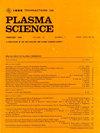Drive Circuit Study of Energy Recovery for Reluctance Coil Launcher
IF 1.3
4区 物理与天体物理
Q3 PHYSICS, FLUIDS & PLASMAS
引用次数: 0
Abstract
The reluctance coil launcher relies on the electromagnetic force generated by the magnetic field formed by the pulsed current in the drive coil to propel the ferromagnetic armature to accelerate. However, during the launching process of the reluctance coil launcher, the armature is subjected to the reverse drag force generated by the coil current after passing through the center position of the coil, which leads to a decrease in the speed of the armature and the efficiency of the launcher. In order to cut off the coil current at the right time, reduce the drag force effect on the armature, and recover the excess energy, this article proposes two circuit topologies for recovering the residual energy, in which the Type 1 energy recovery circuit can recover the energy of the residual current into the capacitor to save power for the next launch and the Type 2 energy recovery circuit improved based on the Type 1 circuit structure can realize that the energy recovered from the previous stage can be used for discharging the subsequent coils. Based on the simulation results, experiments of a two-stage reluctance coil launcher are carried out to validate the feasibility of the energy recovery circuit topologies. The results show that the Type 1 energy recovery circuit increases the efficiency of the original launcher from 7.16% to 10.36% and can recover 10 J of energy to the capacitors. The Type 2 energy recovery circuit has an efficiency of 10.49% and recovers 36.524 J and the Type 2 energy recovery circuit therein, based on the recovery of excess energy, uses that portion of the energy in the next stage of the launch process instead of retaining it until the next launch process, further improving the launch efficiency. The above results provide a new reference for improving the efficiency of the reluctance coil launcher using the circuit topology approach.磁阻线圈发射装置能量回收驱动电路研究
磁阻线圈发射器依靠驱动线圈中脉冲电流形成的磁场所产生的电磁力推动铁磁电枢加速。然而,在磁阻线圈发射器的发射过程中,电枢受到线圈电流通过线圈中心位置后产生的反向阻力,导致电枢速度下降,发射器效率降低。为了在适当的时候切断线圈电流,减少对电枢的阻力影响,回收多余的能量,本文提出了两种回收剩余能量的电路拓扑结构:其中,第1类能量回收电路可将剩余电流的能量回收到电容器中,为下一次发射节省电力;第2类能量回收电路在第1类电路结构的基础上改进,可实现前一级回收的能量可用于后续线圈的放电。基于仿真结果,对两级磁阻线圈发射装置进行了实验,验证了能量回收电路拓扑结构的可行性。结果表明,1型能量回收电路将原发射装置的效率从7.16%提高到10.36%,并可向电容器回收10 J的能量。2型能量回收电路的效率为10.49%,回收36.524 J,其中的2型能量回收电路在回收多余能量的基础上,将这部分能量在下一阶段的发射过程中使用,而不是保留到下一阶段的发射过程,进一步提高了发射效率。上述结果为利用电路拓扑方法提高磁阻线圈发射效率提供了新的参考。
本文章由计算机程序翻译,如有差异,请以英文原文为准。
求助全文
约1分钟内获得全文
求助全文
来源期刊

IEEE Transactions on Plasma Science
物理-物理:流体与等离子体
CiteScore
3.00
自引率
20.00%
发文量
538
审稿时长
3.8 months
期刊介绍:
The scope covers all aspects of the theory and application of plasma science. It includes the following areas: magnetohydrodynamics; thermionics and plasma diodes; basic plasma phenomena; gaseous electronics; microwave/plasma interaction; electron, ion, and plasma sources; space plasmas; intense electron and ion beams; laser-plasma interactions; plasma diagnostics; plasma chemistry and processing; solid-state plasmas; plasma heating; plasma for controlled fusion research; high energy density plasmas; industrial/commercial applications of plasma physics; plasma waves and instabilities; and high power microwave and submillimeter wave generation.
 求助内容:
求助内容: 应助结果提醒方式:
应助结果提醒方式:


